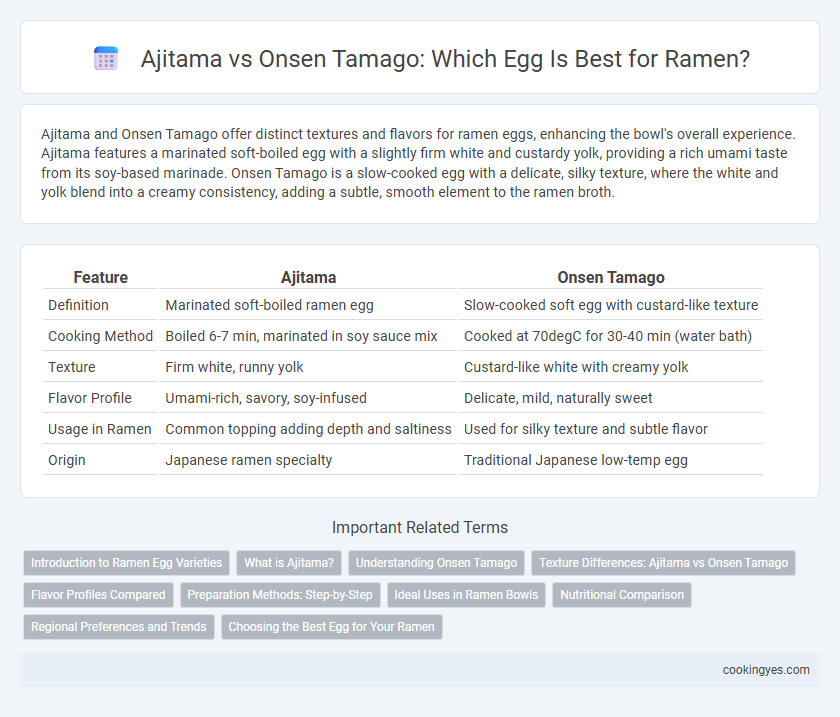Ajitama and Onsen Tamago offer distinct textures and flavors for ramen eggs, enhancing the bowl's overall experience. Ajitama features a marinated soft-boiled egg with a slightly firm white and custardy yolk, providing a rich umami taste from its soy-based marinade. Onsen Tamago is a slow-cooked egg with a delicate, silky texture, where the white and yolk blend into a creamy consistency, adding a subtle, smooth element to the ramen broth.
Table of Comparison
| Feature | Ajitama | Onsen Tamago |
|---|---|---|
| Definition | Marinated soft-boiled ramen egg | Slow-cooked soft egg with custard-like texture |
| Cooking Method | Boiled 6-7 min, marinated in soy sauce mix | Cooked at 70degC for 30-40 min (water bath) |
| Texture | Firm white, runny yolk | Custard-like white with creamy yolk |
| Flavor Profile | Umami-rich, savory, soy-infused | Delicate, mild, naturally sweet |
| Usage in Ramen | Common topping adding depth and saltiness | Used for silky texture and subtle flavor |
| Origin | Japanese ramen specialty | Traditional Japanese low-temp egg |
Introduction to Ramen Egg Varieties
Ajitama and Onsen Tamago are two popular types of ramen eggs, each offering distinct textures and flavors that enhance the overall ramen experience. Ajitama is marinated in a soy-based sauce, resulting in a savory, slightly sweet taste with a firm white and custardy yolk. Onsen Tamago, softly cooked in low-temperature water, features a delicate, silky texture with a mild flavor, complementing ramen broth without overpowering it.
What is Ajitama?
Ajitama is a marinated soft-boiled egg commonly used as a ramen topping, known for its flavorful soy-based marinade that seeps into the custard-like yolk and tender white. Unlike Onsen Tamago, which has a silky, poached texture achieved through slow cooking in hot spring water, Ajitama undergoes a marination process that enhances its savory taste and adds depth to ramen bowls. The rich umami of Ajitama complements the broth, making it a beloved choice for ramen enthusiasts seeking a well-rounded flavor profile.
Understanding Onsen Tamago
Onsen Tamago is a traditional Japanese slow-cooked egg prepared at low temperatures, resulting in a silky texture with a delicate, custard-like white and a creamy yolk that complements ramen perfectly. Unlike Ajitama, which is marinated and has a firmer texture and stronger flavor, Onsen Tamago offers a subtle, natural taste that subtly enhances the rich broth of ramen without overpowering other ingredients. This unique preparation method makes Onsen Tamago ideal for ramen enthusiasts seeking a smooth, melt-in-the-mouth egg experience.
Texture Differences: Ajitama vs Onsen Tamago
Ajitama features a marinated, firm yet creamy yolk with a slightly chewy white, enhancing ramen with its rich, savory texture. Onsen Tamago offers a silky, custard-like consistency where the yolk and white blend softly, providing a delicate, melt-in-the-mouth sensation. These contrasting textures influence the overall ramen experience, with Ajitama bringing a robust bite and Onsen Tamago contributing smoothness and subtlety.
Flavor Profiles Compared
Ajitama ramen eggs offer a rich, savory flavor infused with soy sauce and mirin, creating a slightly sweet and umami-packed profile that enhances the broth. Onsen Tamago presents a delicate, custard-like texture with a subtle, creamy taste that balances the saltiness of the soup without overpowering it. The choice between Ajitama and Onsen Tamago depends on whether a stronger, seasoned flavor or a mild, velvety complement is preferred to elevate the ramen experience.
Preparation Methods: Step-by-Step
Ajitama is prepared by boiling eggs for exactly seven minutes to achieve a slightly runny yolk, then marinating them in a soy-based sauce for at least 12 hours to infuse savory flavors. Onsen Tamago involves slow-cooking eggs at a low temperature of around 70degC (158degF) in hot water for 30-40 minutes, resulting in a custard-like, delicate texture with a softly set yolk. Both methods enhance ramen by offering distinct textures and flavors; ajitama emphasizes a seasoned, firm exterior, while onsen tamago delivers a silky, gentle bite.
Ideal Uses in Ramen Bowls
Ajitama, characterized by its marinated soy-based flavor and slightly firm yolk, is ideal for rich, hearty ramen bowls such as Tonkotsu or Miso ramen, where its savory depth complements robust broths. Onsen Tamago features a delicately silky texture with a softly cooked yolk, perfect for lighter broths like Shoyu or Shio ramen, offering a subtle, creamy contrast without overpowering the soup's nuanced flavors. Choosing between Ajitama and Onsen Tamago depends on balancing the egg's taste and texture to enhance the ramen's overall flavor profile and mouthfeel.
Nutritional Comparison
Ajitama ramen eggs are marinated in soy sauce and mirin, offering a higher sodium content and enhanced umami flavor, while Onsen Tamago are slow-cooked eggs with a delicate texture and lower sodium levels. Nutritionally, Ajitama provides more salt and slight increases in calories due to the marinade, whereas Onsen Tamago retains more natural egg nutrients, including protein and healthy fats, without added sodium. Both deliver essential amino acids and vitamins, but Onsen Tamago is generally preferred for a cleaner nutritional profile in ramen bowls.
Regional Preferences and Trends
Ajitama, characterized by its richly marinated, slightly sweet soy sauce flavor, is predominantly favored in Tokyo-style ramen, reflecting urban Japanese taste preferences. In contrast, Onsen Tamago, a softly cooked egg with a delicate texture originating from hot spring regions, aligns with Kansai ramen trends emphasizing subtlety and natural flavors. Recent culinary trends show a growing fusion approach where ramen shops nationwide incorporate both Ajitama and Onsen Tamago to cater to diverse regional palates and enhance ramen bowl complexity.
Choosing the Best Egg for Your Ramen
Ajitama offers a rich, savory flavor with its marinated soy sauce base, complementing ramen broth by adding umami depth, while Onsen Tamago features a silky, custard-like texture with a subtle, natural sweetness that enhances the broth's creaminess. For a robust, intense taste profile, Ajitama is ideal, especially in shoyu or miso ramen varieties. Onsen Tamago suits lighter, delicate ramen styles like shio, where smoothness and gentle flavor balance are desired.
Ajitama vs Onsen Tamago for ramen eggs Infographic

 cookingyes.com
cookingyes.com